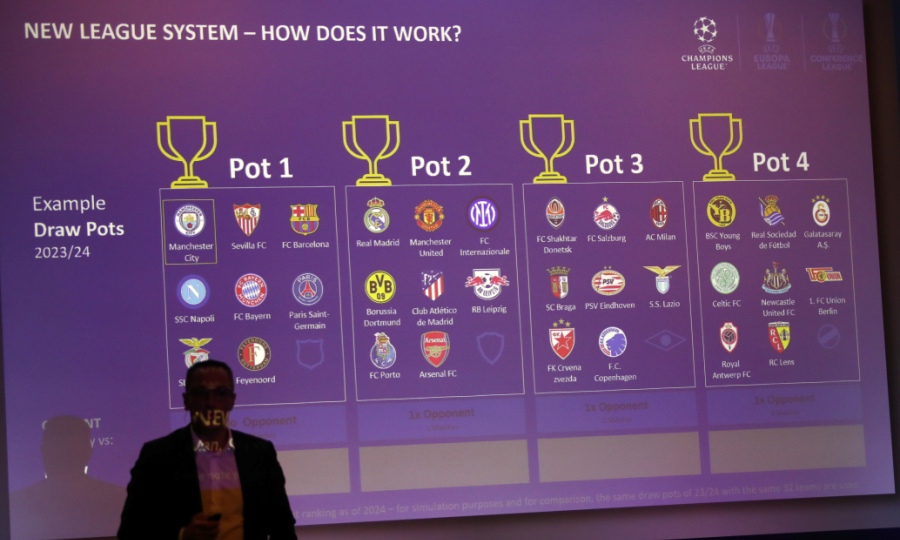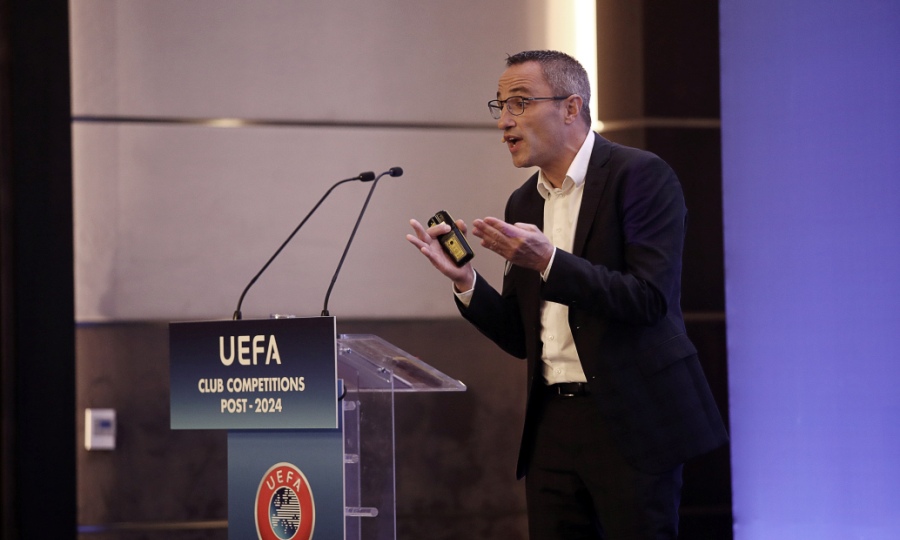The new way of conducting its intercollegiate events UEFA was presented at noon on Tuesday (26/03) by its office Stoiximan Super League 1 and its top executives European Federation.
At the event, its president was the first to speak Stoiximan Super League, Minas Lysandrosspeaking of a milestone year, followed by a brief statement by the UEFA General Secretary, Theodorou Theodoridis.
“You will understand from the presentation that the whole system is done to strengthen the Championships of each country. First the meetings are held with the teams and then with the media to see the opportunities presented by the new system. I will agree with Minas Lysandros that I think Greek football is coming back. Tonight I can’t help but be with one of the two teams in the game in Tbilisi. It’s a year where we show how we can come back.”
In the analysis that followed it was emphasized by the UEFA people and especially by Marchetti how “for us, it is important to understand how the events will take place. I will explain to you the motivations that led us to these decisions. We will explain some details. First we want to say how we always review our events. It’s probably the most revolutionary change we’ve made in 25 years in the Champions League.”
The changes in detail:
How will the Champions League format change from 2024/25?
The key change in the reforms announced by UEFA’s Executive Committee is the abandonment of the current group stage system. The current Champions League group stage features 32 participating teams divided into eight groups of 4 teams each. From the 2024/25 season, 36 clubs will participate in the former Champions League group stage, giving a further four teams the chance to compete with Europe’s best clubs. These 36 clubs will participate in a single league, in which all 36 competing clubs will be ranked in the same single league table.
With the new format, teams will play 8 matches in the new league phase (formerly the group phase). They will no longer face three opponents twice (home and away) but will face 8 different teams, playing four matches at home and four away. To determine the 8 different opponents, the teams will initially be sorted into four capacity groups of nine teams each. Each team will then be drawn to face two opponents from each of these four groups (and from their own capacity group for the first time), playing one home and one away match against each team from the same capacity group .
This gives clubs the chance to test themselves against a wider range of opponents and increases the prospect for fans to see the top teams face off more often and earlier in the competition. The result will also be more competitive matches for all clubs in all positions of the single standings.
How will the extra four places in the Champions League group stage be distributed?
Qualification for the Champions League will continue to be open and will depend on the club’s final position in the previous season’s domestic league competition, combined with each association’s position in the national association’s club contribution rankings. The entry list basis will remain the same as the current season and the four additional places available from 2024/25 (from 32 to 36 teams) will be allocated as follows:
First place: This place goes to the third team in the league of the fifth country in the UEFA ranking, which will no longer participate in the qualifiers, but will have direct participation.
Second place: An additional ticket will be available in the qualification process of the champions of the European championships. Until now, through four qualifying rounds, four champions qualified from the Champions Path, from the new season these positions become five.
Third and fourth place: These places go to the associations with the best collective performances of their teams in the previous season (ie the previous season’s highest association coefficient, which is based on the total number of points achieved by each club from one association divided by the number of clubs that represented it in European competitions). These two confederations will each gain an additional direct place in the new Champions League, over and above what they are normally entitled to.
How will the teams reach the knockout stage of the Champions League and what will the format of the knockout stage change?
The result of each match will decide the final ranking of the new league, with three points for a win and one for a draw.
The top eight teams in the single standings will automatically advance to the round of 16, while the teams finishing 9th to 24th will compete in double knockout play-off matches to secure their place in the round of 16 competition. Teams finishing in 25th to 36th place are eliminated, without moving to the UEFA Europa League.
The new format, with all teams ranked together in one league, will mean that there will be many crucial matches right up until the last matchday of the first phase.
In the knockout stage, teams between 9th and 16th place will face a team that finished between 17th and 24th, with the second leg at home. The eight teams that win the knockout stage play-offs will advance to the round of 16, where they will each face one of the top eight teams, who will have already qualified for the round of 16.
To enhance the synergy between the first round of the single league and the knock-out stages, and to give even more incentive to the first round, the knockout stage pairings will be determined in part by their position in the first round, with a draw or which will ultimately shape the way to the final.
From the round of 16 onwards, the competition will continue to follow the existing knockout format, which leads to the neutral venue of the final, chosen by UEFA.
All pre-final matches will continue to be played in midweek, recognizing the importance of the national fixture calendar across Europe, while the final will continue to be played on Saturday.
Will the Europa League and Europa Conference League formats also change from 2024/25?
Yes. Similar format changes will also apply to the Europa League (8 matches and therefore 8 different opponents in the league phase) and the UEFA Europa Conference League, which from 2024/25 will be called the UEFA Conference League (6 matches and therefore 6 different opponents in the league stage), with both competitions featuring 36 teams in the league stage.
What will the calendar look like with the new three-match format?
Champions League and Europa League first-leg matches will be played between September and January, while Europa Conference League first-leg matches will be played between September and December. Each of the three UEFA club competitions will have an exclusive match week, during which no matches from the other two competitions will be scheduled.
In the remaining weeks, Champions League matches will be played on Tuesdays and Wednesdays, while Europa League and Europa Conference League matches will be played on Thursdays. In the exclusive Champions League week, the Champions League matches will be played on Tuesday, Wednesday and Thursday. In the exclusive Europa League week, Europa League matches will be played on Wednesday and Thursday. In the exclusive Europa Conference League week, the Europa Conference League matches will be played on Thursday.
On the last matchday of the first phase in all three competitions, the 18 matches will be held simultaneously.
How will the new Champions League format benefit fans?
The new league format will feature more European teams in each competition and allow fans to not only see more important European matches, but also see them played earlier in the competition.
The new format will introduce a better competitive balance between all teams, with each team able to face opponents of a similar level of competition throughout the single league.
Every match counts. The new league format will ensure that any result can shape a team’s position, right up to the final matchday. A win or loss in the final match of the league stage could mean the difference between automatic qualification to the round of 16, a place in the play-offs or elimination from the competition.
How will the new Champions League format benefit European football?
The changes made are designed to ensure a positive future for European football at all levels and to meet the evolving needs of all stakeholders. Undoubtedly confirming the common commitment to the principle of open competition and sporting value across the continent, the common goal was also to support national championships. As previously mentioned, the new landscape of UEFA club competitions allows more teams and therefore more managers and players to compete in more competitive matches on the European stage.
UEFA also confirmed its strong financial commitment to European football as a whole and that it will take steps to ensure solidarity is provided to clubs not participating in UEFA club competitions. This will strengthen the strong edifice on which the game is based in Europe.
How has the Champions League changed over the years?
The Champions League and Europa League timelines show in more detail how each competition has evolved, from the beginnings of the UEFA Champions League, which began in 1955, to the UEFA Cup and UEFA Cup Winners’ Cup and more recently to the formats of the UEFA men’s club competitions which exist today.
Source: Sport Fm
I am currently a news writer for News Bulletin247 where I mostly cover sports news. I have always been interested in writing and it is something I am very passionate about. In my spare time, I enjoy reading and spending time with my family and friends.












